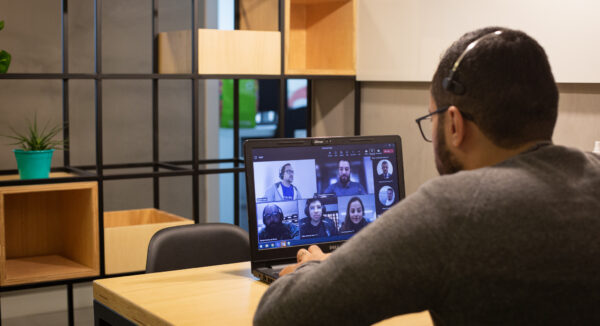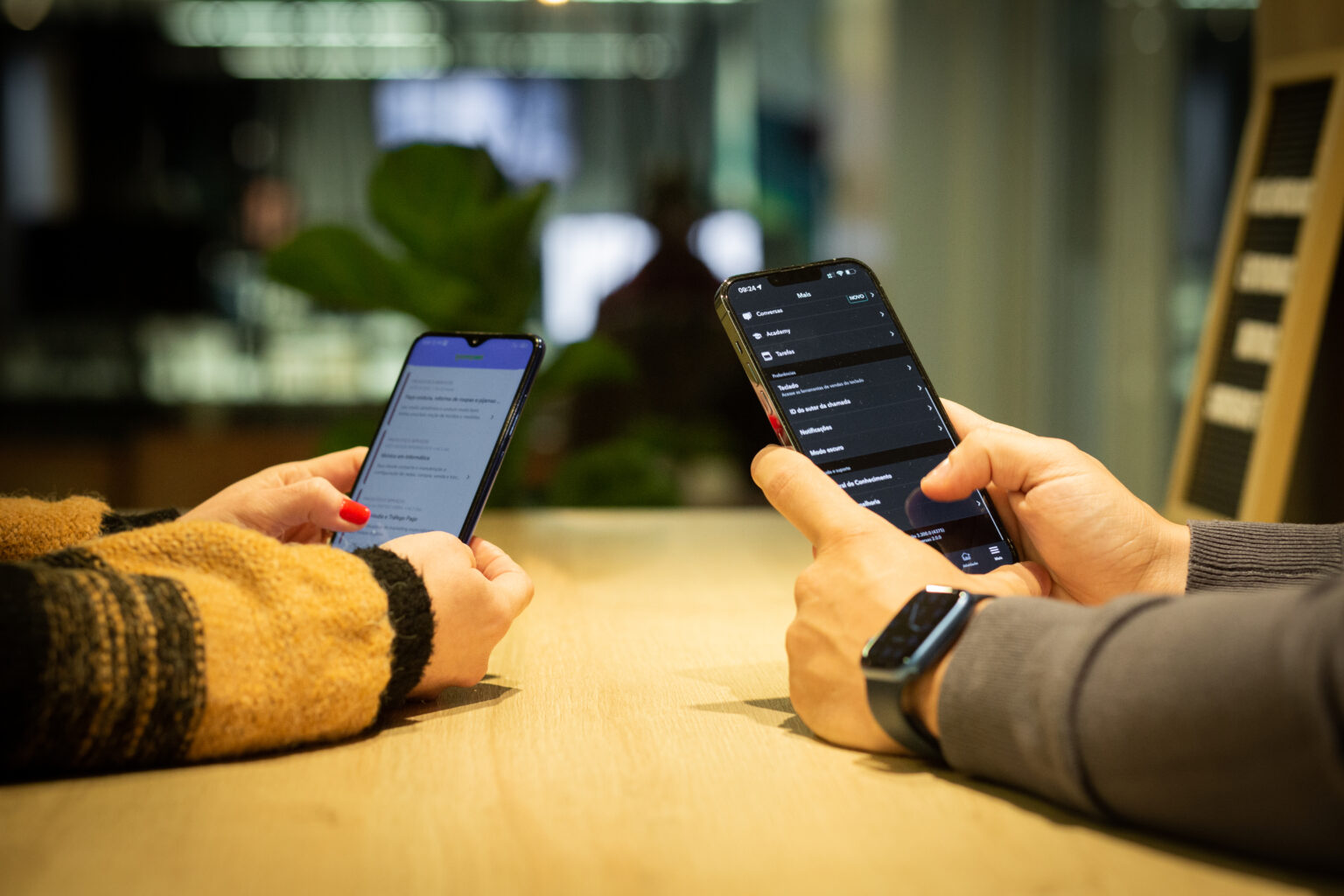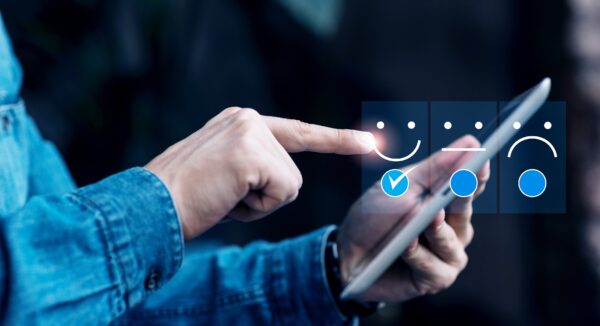
- Digital Business
Product Design is based on user research and understanding, and this can define the success or failure of a digital solution. How many times have you given up making a purchase due to failure in the validation of the payment method? Or how many times have you received error messages when trying to fill out a registration form? These situations alienate potential consumers and negatively impact business.
To ensure that digital solutions are properly developed, according to the target audience, personas, and their pain points, it is essential to invest in Design. With that in mind, we interviewed Priscila Rodrigues, SoftDesign’s Lead Product Designer. In the content below, we explain how it helps to reduce uncertainty and increase user satisfaction.
If your startup or corporate still does not invest in Product Design, you are certainly wasting time, money, and relevance. To change this scenario, fill out the form below and talk to our specialists.
Experience having a reliable partner to your IT challenges. Let’s talk about our unique approach to discover and deliver outstanding solutions.
SoftDesign – Design is one of the pillars of our work, and this is an area that has been growing a lot in the world of Technology. Why?
Priscila Rodrigues – Design has existed for a long time – since the Industrial Revolution – but the IT market still did not see its relevance. In recent years, we have been able to identify that this is an important and powerful tool, because without planning we cannot understand why we develop products and services. Technology without Product Design does not solve problems, it creates new ones.
To prove this idea, in 2018, the McKinsey consulting carried out a survey in order to understand the business value of design. The results obtained showed that corporates that use this knowledge effectively in their culture generated 32% more revenue and 56% more return to shareholders.
This is the largest survey ever conducted in the area, and its outputs make it clear that the market is increasingly aware of the importance of Design. Therefore, corporates that do not understand this will be at a disadvantage compared to others.
SD – In practice, what is the importance of Product Design?
PR – No one wants to consume a product that is not good to use, and this feeling does not come from nowhere, it is not just a personal view of the user. Its origin is often related to usability problems. Thinking about usability is precisely analyzing how a certain person will use an application, enterprise software or platform, and in what context this will take place.
It is impossible to develop a digital product without thinking about the user. If we want solutions to be desired and bought, we need to think about people. That is what Product Design is for. Moreover, it is through research and applications that we provide good experiences in digital products.
SD – Product Design is present in all SoftDesign services. How does it add value in Product Conception and Experimentation?
PR – The first stage of research is carried out in Product Conception. Therefore, customers who use this service can be startups in their early stages or corporates creating solutions (either for internal or external use). At this stage, we seek to understand who the users affected by the product are and what their real needs are.
In Product Experimentation, the previously raised product and business hypotheses are put into practice to test user adherence. Its main mission is to find the product-market fit, that is, to prove that the product solves a pain and, in some cases, that the solution is profitable.
That match is what we seek to find in this service. However, customers often prefer to move from Product Conception directly to Software Development. It is possible, but depending on the case, we do not advise it. This is because the probability of something not working as idealized and with the expected return on investment can be high. We cannot predict user behavior when using a product for the first time. That is why many startups and corporates end up going bankrupt or pivoting their idea.
At SoftDesign, we understand that to streamline this process, the first step should be to test the product quickly and with the lowest possible investment to seek learning. A No-Code or Low-Code MVP, for example, is a simple option to test the idea in the company or market, verifying that the product has adherence and that we can reach the correct users.
Only after successfully completing this phase we can state the solution has a future; and only then we suggest a greater investment of time, effort, and money. We have this concern and transparency with our customers.
SD – Being a human-centered company is one of SoftDesign’s main differentials. Therefore, research and testing of our products are conducted with potential users. Is that correct?
PR – Indeed. Surveys are conducted with real users using various techniques, always looking for profiles that match the business in question. A common mistake when starting a digital business is precisely to conduct these tests and surveys with friends or family. It is natural for such people not to want to displease us and, therefore, they say the idea is great and that they would certainly buy the product. However, there is no guarantee that this action will materialize in the future, as friends and family may not be the personas of the product.
In some cases, the entrepreneur may end up getting excited about these responses to the point of investing a considerable amount in the development of the digital solution. It is highly likely that his idea will not have the expected return. We look for users who really have a profile compatible with the product, to conduct clean research and tests, avoiding origin defects.

SD – You commented on several research techniques. How do we apply User Research in startup apps and corporate enterprise software, for example?
PR – Regardless of whether it is an app or a system, we first need to understand who its users are and the business context. That is the key point. Basically, User Research is to understand user behaviors and needs and there are several techniques available and in use even before Design was popularized, as they originate in Anthropology.
Therefore, what we do is understand which technique makes the most sense in the context we are working with, and how we can customize and mix approaches to reach the given objective. Thinking about it, it is essential that the person who works in Product Design understand research and have an analytical look.
At SoftDesign, we highly value dialogue, which is why we aim to understand who our users and stakeholders are. For this to happen, we conduct structured interviews or informal chats, which allow us to analyze beyond verbal language. We always suggest eye-to-eye conversations, even if they are held remotely. In addition to quantitative research, when numbers and whys must be understood.
The ideal is to make a match between tools and techniques since conversations can replicate a bias. We tend to say things that we do not necessarily do daily, because these actions are already automatic for us. It is precisely at this moment that we perceive usage addictions, but the user does not always notice this movement, as this process has already been naturalized.
SD – After the Product Conception and/or Experimentation stages, the product evolves into Software Development. What is the role of Designers in this phase?
PR – Product Design continues to be part of the development of the digital solution. It is not inserted only in the initial part of research and experimentation. Therefore, we can say that Designers who work in development teams are responsible for giving voice to users throughout the entire creation journey.
In an agile team, for example, in each sprint and release we continue to improve our understanding of personas, creating flows, testing, and validating whether what is being developed in accordance with the discoveries made in discovery stage – what we call User Experience Design (UX Design).
Through it, we ensure that critical issues for the user are not forgotten. We work with a focus on business objectives and continually validate these issues, especially during software development, as we have deadlines and features that need to be built.
In addition, Designers are responsible for materializing journeys, understandings, and interfaces – what we call User Interface (UI). In a product team, it is also our role to create style guides, prototypes and interactions, aiming at better usability.
SD – Are surveys also important to improve the User Experience (UX) and the User Interface (UI)? What is the difference between them? How do they impact product creation?
PR – Yes! Research is essential for us to create fluid and efficient experiences in the products we plan. UX is the User Experience, and it can be generated by several factors. One of them is precisely the Interface Design. In a simplified way, people who work on User Experience focus on research, creating journeys, designing flows, understanding usage and business.
The UI, on the other hand, is focused on the interface, which means that this Designer is the one who will transform the learning from research and user data into screens. At this stage, other architecture and information hierarchy practices, typography, accessibility, application of Gestalt laws, Nielsen’s Heuristics, color theory, among other things, come into play.
Finally, there is a series of essential knowledge to be able to provide a valuable experience from the interface. In addition to the flow and journey, the way the user is seeing and interacting with the product is important. Therefore, even though they have different focuses, UX and UI are complementary disciplines that must go hand in hand.
SD – In practice, it is this work that defines the location of buttons, in addition to how the user will navigate in each application, for example. Can we say that it is the role of the UX/UI Designer to reduce problems and make the journey more intuitive?
PR – Yes! These issues are predicted through Nielsen’s Heuristics, aiming to reduce the cognitive load, that is, the mental effort that the user needs to make to use an enterprise software, platform, or application. Questions like: should I include space between the numbers? Should I add a hyphen? These are examples of thoughts that represent an unnecessary waste of time and energy for the user.
This turns out to be a problem for the company, as every second wasted can impact thousands of conversions that will not happen, like the classic example of the $300 million button. For this reason, every detail matters and this is not an aesthetic issue, as the main objective is not to make it ‘pretty’.
Until recently, Product Design was seen as something superficial. However, its main function in technology is to achieve good usability and connection with users, and this is not achieved through the personal taste of Designers. There is even a strong connection between Design and Psychology, since all these sensations and experiences, whether good or bad, are built based on emotions and triggers.
Therefore, understanding people’s mental model and needs is crucial. For example, we are already used to clicking on an X icon to close something, that is, this is an already established mental model. If in the application that same icon behaves completely differently, that will significantly affect the user experience.
SD – Do UX/UI Designers also need to be aware of behaviors and cultures throughout product development?
PR – It is important to note that the Designers on the team are not the end user. We are aware of what the best practices are, but the context of use is very particular, so it is not possible to simulate. Only the person who uses the product knows whether it is good for their needs. And, sometimes, that same person may even think he/she is satisfied, but we still must understand how long that person takes to perform an action, or to find certain information.
As designers, we do need to consider cultural issues. Remember that what is culturally understood in the universe of colors and usability in Brazil can be completely different in another culture/country. An example of this is Shein website, a Chinese e-commerce which bets on the excessive use of information – a reality that is different from European countries. Culturally this is how Product Design works for Chinese users. Other examples from the same segment are: Shopee and Ali Express.
The perceptions and language of these users are completely different from ours, and this impacts on the creation of products and services. Therefore, it is important to know and delve into the consumer universe to provide incredible experiences.
SD – Product Design is also present in Consulting. How does this service work? What type of business and needs does it serve?
PR – Unlike Product Conception and Product Experimentation, which apply Product Design in the early stages of a business, Consulting is more focused on corporates that already have their digital solution available on the market. These customers already have a significant user base, but for some reason they are not getting the expected return.
Therefore, in the Design Consulting service, we analyze the product and its usability, and carry out qualitative and quantitative research using various techniques. Among them is Shadowing, which allows us to observe the person in their context of use or interacting with a product, allowing us to understand where the origin of the problem is.
Based on this study and in-depth analysis, we were able to propose improvements to solve the identified problems. Be it usability, suggesting new flows and interfaces, or the service. After all, there is no point in analyzing only the interface of an application, since sometimes the gap is in another part of the operation that is not working very well.
I believe that we would be irresponsible if we only delivered a part of the problem analysis. Our investigation seeks to understand the whole: where are the obstacles and how we – a software and technology company – will propose measures to solve them.
SD – Without a pleasant experience, the user will give up using a product. Is that correct?
PR – Yes! That is exactly why corporates that still do not understand the importance of Product Design lose customers. After all, through a simple Google search, users will quickly discover a competitor that is better prepared to meet their needs.
SD – That proves the importance of Product Design. Is representing the voice of the user the key to success?
PR – When I cited McKinsey’s research on the impact of design on business, and how much corporates benefit from it, I emphasized that this benefit does not come for nothing. Consumers need to be heard, mainly because there is a lot of competition and options available in the market.
If I do not like a product, I will just use another one. My money will go towards a solution that suits me better, and that really solves my problem. That is, corporates that believe that investing only in code is enough, have not yet seen the power of Product Design and, very soon, will be stuck in time.
Remember that ‘making it pretty’ does not bring results, it does not add value to the business. It is not possible to create a desired and successful product – that everyone wants to consume – without generating value for people. Design is much more than form, it is also context and function. You can develop the most amazing tool in the world, but if the user does not understand how to use it and if an emotional connection is not established, your product will not be adopted.
In summary, the person who works in Product Design is the one who connects all these parts, along with technology and the business. We are an ecosystem that works towards a digital product.
SD – It is important to highlight that the Designer does not work alone. How does this interaction occur with the other professionals of a product team, such as Product Owners, Managers, QAs, and Programmers?
PR – Development teams are multidisciplinary. So, there are distinct roles. For this interaction to work, communication and dialogue are needed. In addition, each specialist has a different connection and interaction with Product Design.
For example, Product Owners, Managers and Designers work very closely, because while one looks at the business, the other looks at the user. These two visions need to be connected to define what needs to be prioritized, aiming that deliveries generate the greatest possible value within the agreed period.
Today, testing is much more about quality than just how it works. This means that this work is related to the user experience and, therefore, Designers and QAs need to look in the same direction, questioning themselves at all times: what level of quality do we want to deliver?
The same question is asked to programmers. Therefore, one person depends on the other for a given product to be developed, and this interaction needs to be very efficient to respect established negotiations. Designers also need to know what the limitations of the chosen technology are: does it support interactive animations in its interface, for example?
For that, co-creation is constant, as well as refinement – an important stage of the project, as it is when the team meets to analyze the proposed solution – identifying technical and feasibility issues. We are specialists, each with a different expertise, seeking to achieve the same result: incredible digital products.
SD – What is the profile of Designers at SoftDesign?
PR – Our Designers have a more generalist profile, as we work in all stages: from discovery to delivery. For this reason, we conduct research, analysis, and journey definitions, as well as the creation of interfaces and usability tests.
In addition to these hard skills, we also value soft skills, as we understand that being technically good is not enough, you also need curiosity and autonomy. The person specializing in Product Design needs to be curious and have an active voice. We represent users throughout development and need to be able to communicate their needs.


